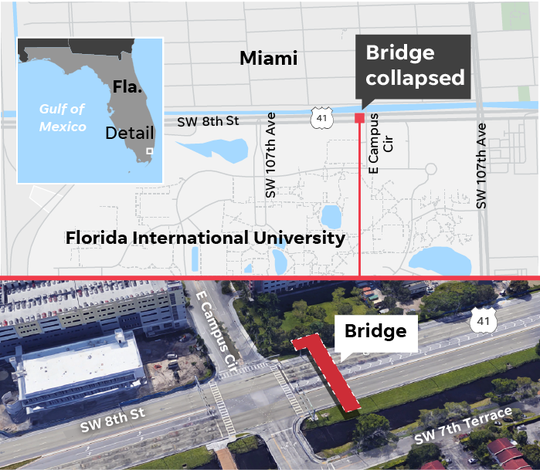A doomed design was the "probable cause" of the horrific collapse of a pedestrian bridge in Miami last year that killed six people and injured 10, the National Transportation Safety Board found Tuesday.
The 174-foot-bridge section, designed to connect Florida International University with the city of Sweetwater, was still under construction on March 15, 2018, when it crashed to the road below. Eight vehicles were crushed, seven of which were occupied.
A peer review that failed to detect the calculation errors by designer FIGG Bridge Engineers – and an engineer's failure to recognize the importance of cracking before the collapse – contributed to the tragedy, the board said.
"FIGG Bridge Engineers severely underestimated the demand on the bridge, significantly overestimated the bridge’s capacity ... among other calculation errors," NTSB Chairman Robert Sumwalt said. "But another structure failed in this accident, the structure of public safety oversight."
NTSB staffer Dan Walsh said the construction was "high-risk" because of the complex design of the bridge. But he added that the school was overseeing the project, and the state Transportation Department was not required to have an inspector on site.
"Our recommendations address this issue, that FDOT should have more authority on this type of project," Walsh said
A full report will be published in about three weeks. But Tuesday's findings were in line with an investigative update from the NTSB a year ago saying FIGG overestimated how much stress the structure could take. Cracking observed in the bridge before the collapse was consistent with those design errors, the NTSB said at the time.
The company took issue with Tuesday's findings. "At the NTSB meeting today, it was evident that the investigation into the FIU pedestrian bridge construction accident presented challenges for the agency to accurately understand all of the technical and factual components," FIGG said in a statement. "The accident was the result of a complex series of events and failings by parties at multiple stages of the project."
FIGG said the cracks had shown no signs of expanding and had not appeared to present a safety concern. The company said a separate independent analysis by a forensic structural engineering firm showed that if a construction joint on the bridge had been built as required by state specifications, the accident would not have occurred.
A blistering report released in June by the U.S. Occupational Safety and Health Administration said at least one worker had alerted engineers of extensive cracking before the bridge fell. That should have prompted an order to close the street below and reinforcement of the structure, OSHA said.
Two days before the collapse, a FIGG engineer left a voicemail with state transportation officials warning of cracks in the structure. A transcript of a voicemail from W. Denney Pate included Pate saying “some cracking” had been observed on the north end of the span.

SOURCE National Transportation Safety Board (Photo: USA TODAY)
“We’ve taken a look at it and, uh, obviously some repairs or whatever will have to be done, but from a safety perspective we don’t see that there’s any issue there so we’re not concerned about it from that perspective," Pate said. "Although obviously the cracking is not good and something's going to have to be, ya know, done to repair that."
The board issued several recommendations to ensure that additional guidance will allow designers to better determine loads; that plans will undergo peer review by a qualified independent firm; that proper action will be taken any time structural cracks are noticed; that uncommon designs will receive appropriate attention from the Florida Department of Transportation to ensure compliance; and that discussions of redundancy are included in manuals and guidelines, especially in relation to uncommon designs.
"These recommendations will make it less likely that an error will be made, and more likely that the error will be caught, before concrete is ever poured," Sumwalt said.
The $14.2 million bridge, when completed, would have been 289 feet long and 109 feet tall. The bridge was being built under “accelerated bridge construction” methods championed at FIU. The methods allow larger pieces to be fabricated away from traffic, rather than assembling smaller pieces above a busy road.
Walsh said Tuesday that the collapse did not appear to be related to the accelerated method.
FIU President Mark Rosenberg lauded the project when the section was dropped into place days before the tragedy.
“FIU is about building bridges and student safety," Rosenberg said. "This project accomplishes our mission beautifully."

SOURCE maps4news.com/ ©HERE, Google Maps (Photo: USA TODAY)
Contributing: Bart Jansen and Alan Gomez
|